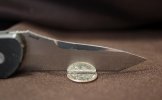- Joined
- Feb 15, 2008
- Messages
- 131
Here is the Benchmade 9500 Mini Stryker from a regular camera after applying first the convex bevel (16°-20° per side), then the micro-bevel (20° per side):

ZOOM
The micro-bevel is barely visible to the naked eye.
Applying the micro-bevel was a very quick matter of a few strokes per side with the 1600 grit ceramic stones. My theory for the bevel geometry is the following:
With thin, polished and convex shoulders, drag should be minimal when cutting and because the shoulders are so close up behind the cutting edge, they'll enter the cut quickly, spreading the cut apart and reducing stress on the apex of the edge. The V-grind mirco-bevel should be a more precise cutter than a convex-to-the-edge bevel, reducing some of the deflection I find with purely convex edges. The extra width of the micro-bevel at 20° per side should make it a little tougher. Now for some testing....

ZOOM
The micro-bevel is barely visible to the naked eye.
Applying the micro-bevel was a very quick matter of a few strokes per side with the 1600 grit ceramic stones. My theory for the bevel geometry is the following:
With thin, polished and convex shoulders, drag should be minimal when cutting and because the shoulders are so close up behind the cutting edge, they'll enter the cut quickly, spreading the cut apart and reducing stress on the apex of the edge. The V-grind mirco-bevel should be a more precise cutter than a convex-to-the-edge bevel, reducing some of the deflection I find with purely convex edges. The extra width of the micro-bevel at 20° per side should make it a little tougher. Now for some testing....
Last edited:
